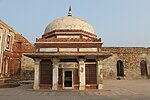Metcalfe House is the name given to two residential houses built in the 19th century in Delhi; one is near Old Delhi Civil Lines and the other is in Mehrauli, South Delhi. These were built by Sir Thomas Theophilus Metcalfe, 4th Baronet (1795–1853), a Civil Servant, when he was the Governor General’s last British Resident (Agent) at the Mughal Court of Emperor Bahadur Shah Zafar II.The first house near the Civil Lines, called the ‘town house’, was built in 1835 in colonial style, near the present day Inter State Bus Terminal (ISBT). He resided there till his death in 1853. It was badly damaged during the 1857 Indian War of Independence (well known as the Uprising). It was repaired subsequently. His son Sir Theophilus Metcalfe (who was deeply involved during British counter offensive to the Uprising) inherited it. The house exchanged hands several times before it finally came under the possession of the Government of India. Between 1920 and 1926, it also remained the seat of the Council of State of the Central Legislative Assembly, which eventually paved way for the present Rajya Sabha, till the inauguration of the Parliament House in New Delhi. It now houses the highly secured offices and residences of the Defence Scientific Information & Documentation Centre (DESIDOC) and Defence Terrain Research Laboratory (DTRL), and many other divisions of the Defence Research & Development Organisation (DRDO). It is out of limits for visitors and photography.The second Metcalfe House, known as ‘the retreat’ or ‘Dilkhusha’, was also built by Sir Thomas Theophilus Metcalfe as a country house in Mehrauli in South Delhi in Qutb Complex. 'Dilkhusha' in Urdu language means "Delight of the Heart". He refurbished the 16th century Mughal tomb of Quli Khan in true English style as a pleasure retreat by surrounding it with many rest houses, follies and gardens. He used to lease out his retreat as a guest house to honeymooning couples, as it provided an idyllic view of the Qutub Minar with its surrounding structures. An inscription at site (photo of plaque in the gallery) testifies that Metcalfe rented out this house to honeymooning couples.








